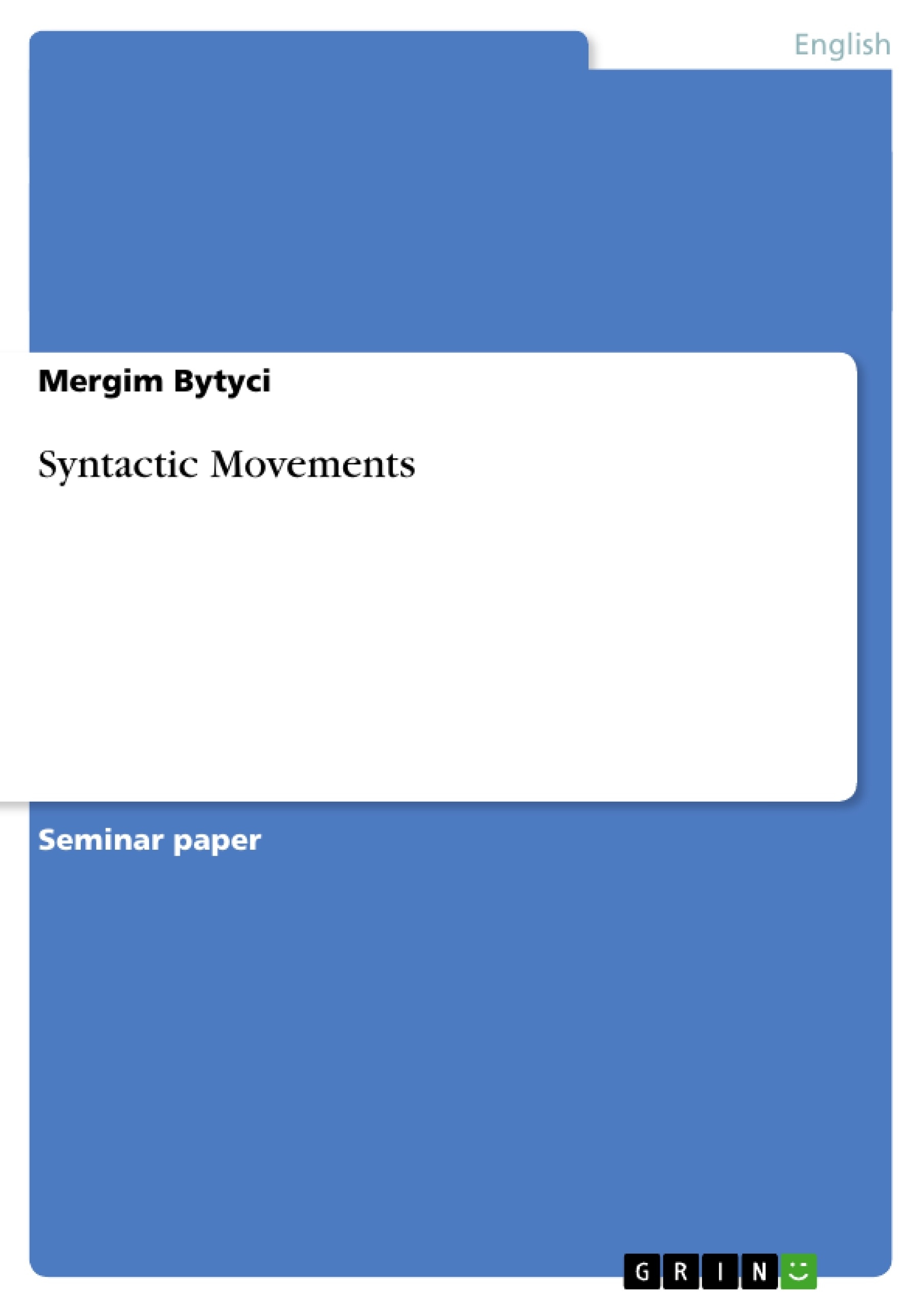1. Introduction
In the course of this term paper I will analyze three kinds of syntactic movements, which will be the Head Movement, Argument Movement and the Wh-Movement.
Initially I will defer to basic knowledge such as Feature Checking, Merge and C-Command since these operations are the basis of syntactic comprehension.
After a short introduction I will briefly discuss and explain the Head Movement and the Argument Movement with the help of examples before I focus on the latter, namely the Wh-Movement. This syntactic operation will be the core of this paper. I will try to analyze the latest concepts and approaches to this issue and try to illustrate the way Wh-Movement takes place by several examples.
I decided to concentrate on Adger’s and Radford’s points of view on this topic since they rate among the most accepted syntacticians worldwide. Despite this I will parse their statements very closely and try to find potential differences or grievances.
An interesting question will be whether all operations can be explained in a plausible way or if there are arbitrary assumptions without any evidence.
2. Feature Checking
Syntacticians assume that every word of a sentence bears certain features. These features are called categorial-selectional (or c-selectional) features and can be either interpretable or uninterpretable. A noun, for example, bears an interpretable feature [N], a verb [V], an adverbial [Adv] and a preposition the feature [P].
A verb cannot stand alone in a sentence but it needs the existence of a subject. In order to explain this phenomenon linguists came to the assumption that a verb has to bear uninterpretable features as well.
Since a verb needs the presence of a subject, which usually is a DP, it is assumed that the verb bears next to the interpretable feature [V] the uninterpretable feature [N] (abbreviated [uN]).
2.1 Merge
This uninterpretable feature has to be checked and deleted in order to form a grammatically correct sentence. This happens via the operation of Merge. Merge can only
Inhaltsverzeichnis (Table of Contents)
- Introduction
- Feature Checking
- Merge
- Constituent-command
- Head Movement
- Argument Movement
- Wh-Movement
- Wh-expressions
- Auxiliary questions
- Do-support
- Yes/no questions
- Echo-questions
- Subject wh-questions
- Conclusion
Zielsetzung und Themenschwerpunkte (Objectives and Key Themes)
This term paper aims to analyze three kinds of syntactic movements: Head Movement, Argument Movement, and Wh-Movement. The paper begins with a brief overview of Feature Checking, Merge, and C-Command as foundational concepts. The focus then shifts to Head Movement and Argument Movement, before delving into a detailed analysis of Wh-Movement. The analysis will draw upon the perspectives of Adger and Radford, prominent figures in the field of syntax, to illustrate various approaches to this topic. The paper seeks to explore whether all operations can be explained in a plausible manner or if arbitrary assumptions are made.- Syntactic Movement (Head Movement, Argument Movement, Wh-Movement)
- Feature Checking and its role in grammatical sentence formation
- The concepts of Merge and Constituent-command in syntactic analysis
- The theoretical perspectives of Adger and Radford on Wh-Movement
- Evaluation of the plausibility and evidence-based nature of the proposed syntactic operations
Zusammenfassung der Kapitel (Chapter Summaries)
- Introduction: The paper introduces the three main syntactic movements to be analyzed: Head Movement, Argument Movement, and Wh-Movement. It also mentions the basic concepts of Feature Checking, Merge, and C-Command as the foundation for the analysis.
- Feature Checking: This chapter explains the concept of features associated with words in a sentence, including interpretable and uninterpretable features. It highlights the importance of checking and deleting uninterpretable features, which is facilitated by the operation of Merge.
- Merge: The concept of Merge is elaborated upon, emphasizing its role in checking and deleting uninterpretable features by merging words with matching categorial features. Examples of intransitive, transitive, and ditransitive verbs are presented to illustrate the connection between uninterpretable features and thematic roles.
- Constituent-command: This chapter introduces the concept of constituent-command, explaining how it governs relationships between nodes in a sentence. The concept is illustrated with examples of reflexive pronouns, demonstrating how constituent-command determines the realization of pronouns.
- Head Movement: This chapter focuses on Head Movement, where the head of one phrase merges with the head of another. The movement of auxiliaries in Perfect sentences and the movement of T to C in Subject-Auxiliary-Inversion clauses are discussed as key examples.
- Argument Movement: The concept of Argument Movement is explained, which involves a DP moving from a complement position to the subject position. The chapter provides an example of passivisation to illustrate this type of movement.
Schlüsselwörter (Keywords)
This paper focuses on key concepts in syntax, including Feature Checking, Merge, Constituent-command, Head Movement, Argument Movement, and Wh-Movement. The analysis draws upon the theoretical perspectives of prominent linguists, Adger and Radford, and aims to evaluate the plausibility and evidence-based nature of these syntactic operations.- Quote paper
- Mergim Bytyci (Author), 2008, Syntactic Movements , Munich, GRIN Verlag, https://www.grin.com/document/134707




